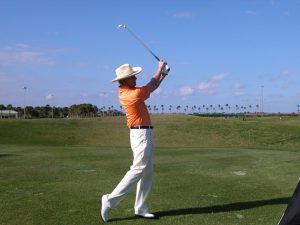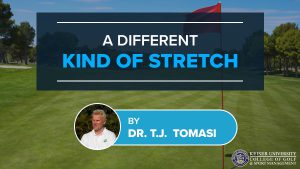A Different Kind of Stretch
By Dr. T. J. Tomasi, Keiser University College of Golf Senior Faculty and Director of Research
An important physical attribute for playing your best golf is physical flexibility. While being flexible is no assurance that you will be a good golfer, it’s for sure that not having it severely limits your options. A highly flexible person can adapt to any swing type. For example, Tiger Woods can swing with a short backswing and low hands or a long backswing and high hands, whereas a thick-chested nonflexible golfer almost always has low hands and a short backswing.
Given the above, it’s no wonder that as you lose your flexibility, your swing-type options narrow substantially. Please remember that flexibility is not simply being limber enough to touch your toes. Flexible muscles, because of their ability to stretch, are a major factor in generating clubhead speed. So given the above, the fact that humans lose flexibility as they age is bad news – by the time you’re 50, your golf swing has lost some of that powerful zip it had when you were in your prime. But the good news is that you can intervene to mitigate this loss of flexibility through exercise.
This inevitability brought by aging is one reason golf teachers should be more than just ‘familiar’ with the concept of flexibility.
The Stretch Reflex
When a muscle is stretched, an electrical signal is sent to the spine describing how much the muscle is lengthened. Based on this info, the signal instigates the stretch reflex, a muscle contraction that prevents the stretching action from continuing. Since the speed of adjustment is necessary for maximum protection in real-time, this automatic reflex never makes it to the brain. This is the basis of plyometric exercises where the golfer turns stretch power into explosive club head speed.
If I had to give you just one exercise to develop a powerful golf swing, it would be the pelvic pistol, a ballistic jumping-like movement similar to a frog leaping onto the lily pad. Power in the swing comes from utilizing ground forces multiplied as they are funneled up through the legs and butt, which are some of your body’s largest and most powerful muscles. The weak arm swing that so many golfers make leaves out these powerful multipliers, a mistake no golfer can ultimately afford to make.
Since this is an explosive movement, it is only for healthy golfers. In any case, start slowly and make sure to check with your doctor before you do ballistic exercises.
To execute the pelvic pistol, first, you cock your pelvis by squatting down until your thighs are just short of parallel with the ground — make sure your fanny is jutting out behind you. Then push up and out of the squat like a competitive swimmer when the gun goes off, thrusting your belly button toward the target until the body is straight. Most pros and juniors can even curve the body with a slight bow at the waist away from the target. But take care not to spend much time in the squat – as soon as you attain a cocked pelvic pistol, thrust up and out of it.

I’m swinging an eight iron where there is no need to squeeze a few more yards from the swing –drop down a club rather than force it. Still, you can see the structure of the Pelvic Pistol.

At the top of my swing, I was in the Pelvic Pistol squat at an angle of about 20 degrees. At this point in the follow-through, there is no angle to my pelvis, indicating that the power from my thighs and glutes is delivered to the ball. When I was younger, and my back was still healthy, my squat at the top with the driver was more pronounced – and the walk to my tee shots was much longer.
If you’d like to study with Dr. Tomasi and other PGA Master Professionals, contact The College of Golf today.















